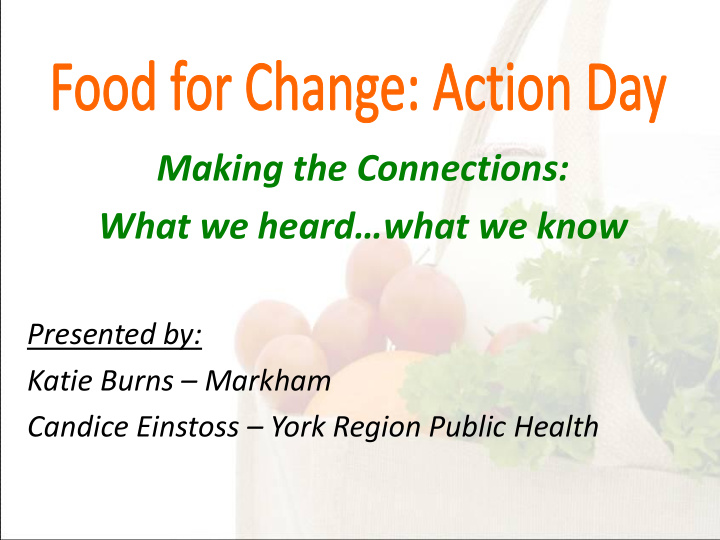



Making the Connections: What we heard…what we know Presented by: Katie Burns – Markham Candice Einstoss – York Region Public Health
What is a Food Charter? • A statement of values and principles to guide food and agriculture policy • Developed by a broad spectrum of community interests and organizations • Addresses a range of issues and opportunities related to food and agriculture • Unique for each community
Why do we need a Food Charter? • To respond to an increasing awareness and interest in food and agriculture • To bring together stakeholders working on all parts of the food system • To develop a baseline understanding of the current state of food and agriculture • To foster understanding, education and partnerships • To prioritize issues, opportunities and action
What will a Food Charter do? • Provide direction for municipalities and community organizations – Decision-making – Policy – Programs • Promote collaboration between different sectors • Kick-start action projects
Elements of York Regions’ Food Charter • Action-oriented – Commitments – Actions • Measure Progress – Short and long-term indicators • Working Document – Review periodically – Update regularly
York Region’s Food Charter?
What makes a good indicator? • Representative of the issue being considered • Easy to interpret/understand • Data available • Invites action • Can track over time
Food for Change: Building a Food Charter Nov 9 2011 Conversation Café Themes • Health & Wellbeing • Education • Economic Development and Sustainability • Environment & Ecological Health • Equity and Social Justice • Culture & Celebration
What we know Health & Wellbeing: • 26% of Ontario children and youth ages 2-17 are overweight or obese • 60% of children and youth consume fewer than 5 servings of vegetables and fruit per day • 42% of adults consume more than 5 servings of vegetables and fruit per day • People are more likely to meet their nutrition needs when healthy, affordable food are easily accessible
Proposed Indicators: Health & Wellbeing: • York Region Food Desert Mapping • Fruit and Vegetable consumption • # of school breakfast/food programs • Obesity rates • Map fast food vs. fresh food retail/restaurants
What we know Equity & Social Justice: • In 2010, York Region food banks provided food for over 52,000 (up 20% from 2008) • 1 in 8 of York Region residents live in low- income families • Cost of feeding a family of 4: $177. 86/week
Proposed Indicators: Equity and Social Justice: • Use of food banks • Cost of the food basket • Food programs and services focused on addressing poverty • Food programs and services focused on supporting new Canadians • Farmer incomes, cost of farm land
What we know Culture and Celebration: • York Region is home to more than 200 distinct ethnic groups • Two out of five residents are visible minorities • Many different cultural and food celebrations across the Region • Food brings people together
Proposed Indicators: Culture and Celebration: • # of cultural events and festivals • Local media stories and social media (blogs, facebook, twitter, etc.) focused on food • Restaurants and retailers that serve York Region grown food • # of organizations working on food in York Region • # of religious organizations, culturally specific programs
What we know Education: • York Region Food for Learning – providing breakfast and snack programs to approximately 24,000 students • Limited food skills/literacy programs available - need to enhance education of food preparation, meal planning, cooking skills, label reading and making healthy food choices • There are currently 4 school gardens and 10 community gardens
Proposed Indicators: Education: • # of food education programs (skills, cooking, nutrition, gardening, etc.) • # of school gardens/kitchens • # of community gardens/kitchens • Farmer to farmer education opportunities (internships, mentorship, incubators, etc.)
What we know Economic Development and Sustainability: • There are approx. 4,300 jobs in York Region’s agricultural industry • There are 9 farmers' markets in the Region that offer locally grown seasonal, agricultural products • Local food procurement policy - 1
Proposed Indicators: Economic Development: • Farmer and farming statistics, # of farms & farmers, demographics (ageing trend), farm sales • # of farmers markets, on-farm markets, CSAs, and other local food purchasing options • # of food processors, breakdown by type • # of local food procurement policies in large institutions • Agri-tourism sector
What we know Environment • York Region is home to the one of richest agricultural lands in Ontario • Approx. 38% of York Region’s land use is devoted to farming activities • Increasing consumer interest in locally grown food, reducing food miles and minimizing green-house emissions
Proposed Indicators: Environment: • Agricultural land use v. other types of land use • Urban agriculture, land use • % of farms with Environmental Farm Plans • Food waste/Community composting • Food miles
Next Steps… Let’s make connections and start the conversation! • What is your response to what you have heard so far today? • From your perspective, what do you see as the next steps? • Who should be involved? Looking for involvement from you!
Recommend
More recommend